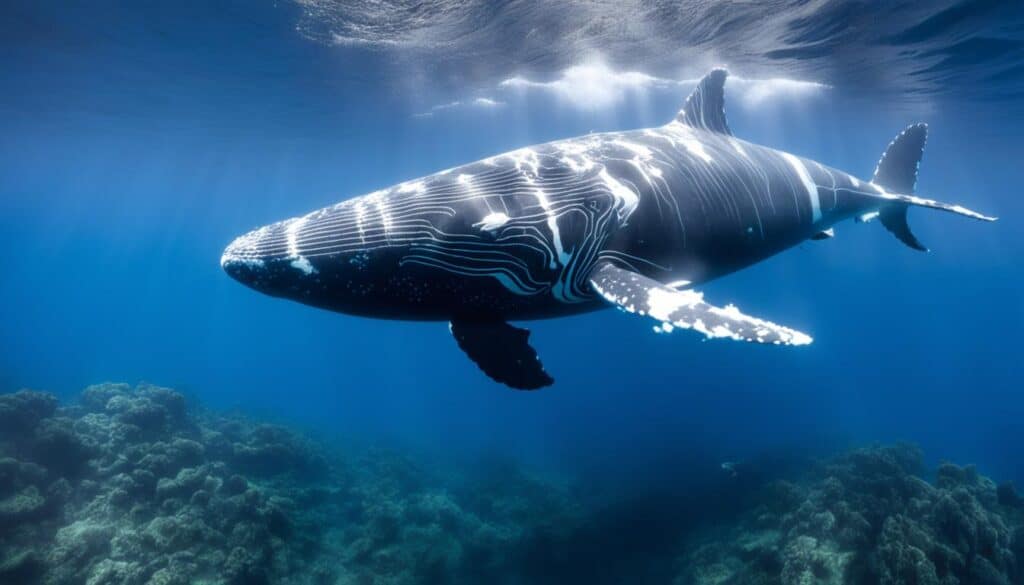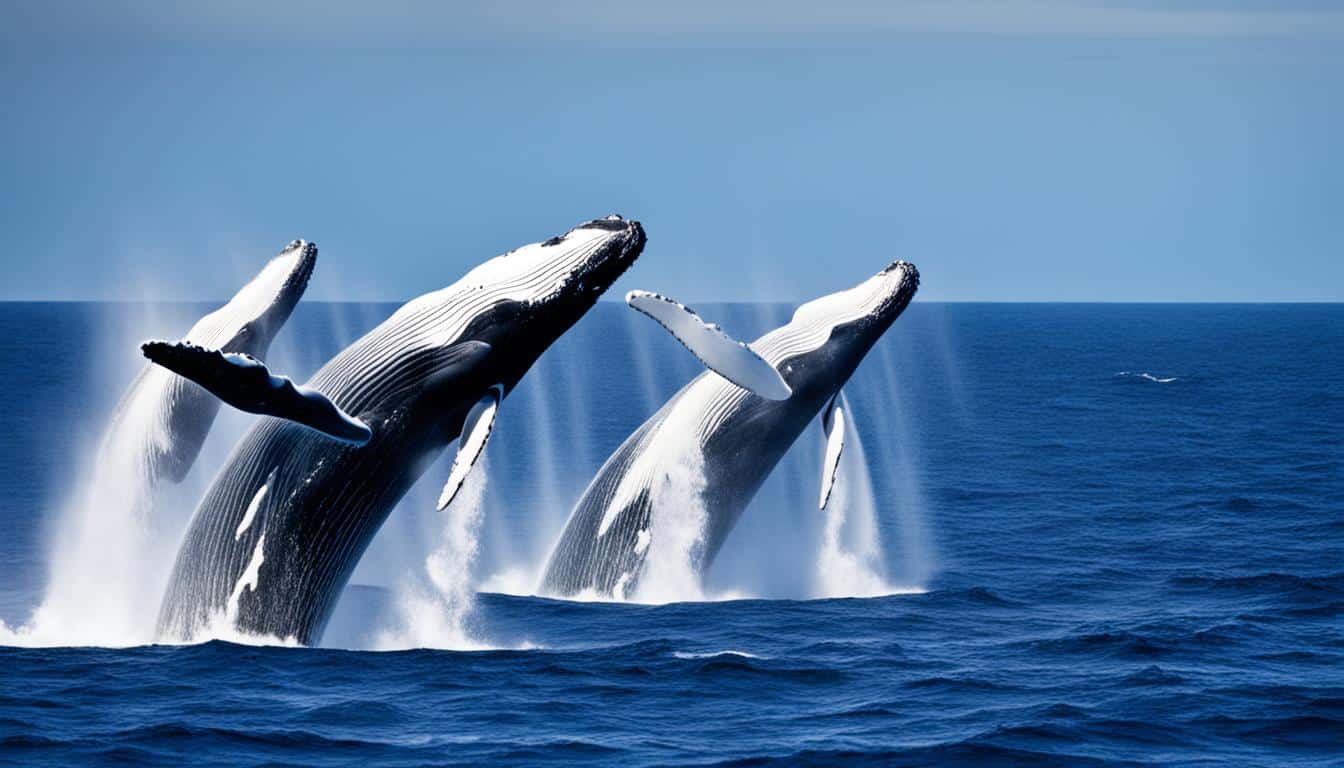Ever thought about how whales talk to each other under the sea? Learning about whale communication is a deep dive into their world. They use many ways to talk, from songs to special sounds. By exploring marine mammal communication, you’ll see how they send messages, show feelings, and keep social ties. Join us on this journey to learn more about whale communication!
Understanding the Complexity of Whale Communication
Whales use a wide range of sounds to talk to each other. Each sound is special and fits the needs of different whales. These sounds help whales share messages, show social ties, and tell where they’re from.
Differences Between Species and Their Vocalizations
Every whale type has its own way of making sounds. Sperm whales use clicks that sound like Morse code. Humpback whales sing complex songs. These sounds help whales stay connected in their groups.
The table below shows how different whales make sounds:
| Species | Vocalization Type | Characteristics |
|---|---|---|
| Sperm Whale | Clicks | Morse-code-like structure for navigation and social interaction |
| Humpback Whale | Songs | Long, complex sequences that can last up to 30 minutes |
| Orca | Calls | Distinctive sounds, including whistles and pulsed calls unique to pods |
Unique Dialects Among Whale Clans
Whales have their own special ways of speaking, like human accents. These sounds help identify who’s in a group. They also make the bonds between whales stronger.
These differences in sounds help whales recognize each other and stay connected in their groups.
How do Whales Communicate?
Whales have complex ways to talk to each other, using sounds and social groups. To understand them, we look at their vocalizations and how they live together, especially in sperm whales.
The Role of Sperm Whales and Their Codas
Sperm whales use special sounds underwater called codas to talk to each other. These clicks mean different things in different situations. It shows how they connect and understand each other in their social groups.
Interpreting Whale Sounds through Context
Context is key in whale communication. Different sounds mean different things based on the situation and who makes them. By knowing this, scientists can better understand the complex language of whales. This helps us see how these amazing animals interact with each other.
Methods of Whale Communication
Whales have complex ways of talking to each other in the ocean. They use sounds and body language to share important info. This helps us understand their social lives and how they connect with each other.
Socialization Signals Among Marine Mammals
Whales use different signals for various needs. Some main signals are:
- Clicks: For finding their way and navigating.
- Whistles: To stay in touch and share feelings and social info.
- Body Language: Actions like jumping or slapping their tail show emotions like joy or anger.
Exploring Whale Language Patterns
Scientists study whale sounds to learn about their language. They look for dialects, which show how whales live together. By using special tools, they can figure out what the sounds mean.
| Aspect | Details |
|---|---|
| Species Variations | Each species has its own way of communicating, like humpback whales’ unique songs. |
| Locational Dialects | Whales in the same area develop their own special sounds over time. |
| Social Implications | How whales talk affects how they interact and organize themselves in groups. |
Deciphering Whale Vocalizations
Understanding whale sounds is a big challenge that now uses new tech. Tools like artificial intelligence help us make sense of these underwater voices. Researchers are working hard to figure out what these sounds mean.
The Use of Artificial Intelligence in Whale Research
Artificial intelligence is changing whale research. It helps scientists look through lots of sound data. By using machine learning, they can spot patterns in the sounds. This is key to learning how different whales talk to each other.
Project CETI: Bridging the Communication Gap
Project CETI is a big step forward. It uses AI to help humans understand whales, especially sperm whales. By looking at sounds and using neural networks, it aims to grasp the social and emotional depth of whale voices. This tech and biology mix is a big leap in learning how whales share info.

| Method | Description | Benefits |
|---|---|---|
| Artificial Intelligence | Using algorithms to analyze vocal frequencies and patterns. | Enhances accuracy and speed in deciphering vocalizations. |
| Project CETI | A dedicated project focused on understanding sperm whale communication. | Bridges the communication gap between humans and whales. |
| Neural Networks | Using advanced computing to make sense of large data sets. | Identifies complex patterns in whale sounds that might be missed otherwise. |
The Impact of Human Activity on Whale Communication
Human actions are making it hard for whales to communicate. Noise from ships, factories, and other human sources is getting louder. This noise covers up the sounds whales use to talk to each other and find their way.
This noise messes with their social life and survival skills. It’s like trying to have a conversation in a busy city.
Noise Pollution and Its Effects on Marine Mammals
Whales use sounds to talk to each other. These sounds help them find a mate, warn others of danger, and navigate. But when there’s too much noise, they can’t hear each other.
They try to make their voices louder to be heard, but this can be tiring. It affects how they find food, mate, and talk over long distances.
Conservation Efforts to Preserve Whale Communication Channels
We need to do more to protect whales from noise pollution. Creating safe areas in the ocean helps reduce human disturbance. Setting rules for boat speeds and using quieter technology is also important.
Working together, governments, groups, and scientists can make a difference. They can help whales keep their ways of communicating.
The Future of Whale Communication Research
Exploring whale communication research is exciting, with new discoveries on the horizon. Technology and new analysis methods are key to unlocking the secrets of whale communication. Projects like Project CETI are leading the way, making whale dialogues easier to study for scientists and conservationists.
Combining linguistics, artificial intelligence, and marine biology will boost marine biology research. This mix of fields helps scientists link sounds to whale behavior and social groups. By understanding these sounds better, we can learn more about whale societies and what they need.
Studying whale communication is vital for conservation. As researchers learn more about whale language, they can better protect these amazing animals and their homes. The progress in this area will increase our respect for whales and help save them for the future.
FAQ
How do whales communicate with each other?
Whales use clicks, whistles, and songs to talk to each other. Each type of whale has its own way of communicating. This helps them stay connected in their groups.
What are whale vocalizations and their significance?
Whale vocalizations are the sounds whales make, like clicks and songs. These sounds are key for talking to each other. They tell us who they are, how they feel, and what they know about their world.
What does it mean that whales have unique dialects?
Whales in different groups make their own sounds over time. These sounds are like accents for whales. They help whales know who’s in their group and strengthen their bonds.
How do sperm whales specifically communicate?
Sperm whales use clicks called codas for talking to each other. These codas are important for social life. They help sperm whales share information and behave socially.
How does context affect the interpretation of whale sounds?
The situation and who makes the sound matter a lot for understanding whale sounds. It affects how other whales hear and react to them.
What role does artificial intelligence play in whale communication research?
Artificial intelligence helps scientists study whale sounds. Tools like Project CETI use machines to learn from lots of sound data. This helps scientists figure out what whales are saying and how they communicate.
How does human noise pollution impact whale communication?
Noise from humans, like from ships, can make it hard for whales to talk to each other. This can hurt their social life and survival. We need to protect their way of communicating.
What conservation efforts are being made to protect whale communication?
We’re making marine protected areas and rules to lessen ocean noise. These steps help keep whales’ communication safe. They let whales keep their social life and find their way.
What does the future hold for whale communication research?
The future is bright for studying whale communication. New tech and methods are helping us learn more. Projects like Project CETI will bring new insights and help protect whales.
Source Links
- https://www.theatlantic.com/science/archive/2024/02/talking-whales-project-ceti/677549/
- https://www.nationalgeographic.com/animals/article/scientists-plan-to-use-ai-to-try-to-decode-the-language-of-whales
- https://www.newscientist.com/article/2079089-whale-algorithm-could-unlock-secrets-of-their-many-dialects/







